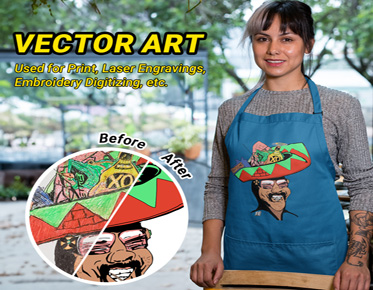Vector Art in Advertising: Harnessing the Power of Bold Designs to Captivate Audiences
In today's visually-driven world, advertising has become increasingly competitive, with brands vying for consumers' attention amidst a sea of distractions. In this landscape, vector art has emerged as a powerful tool for advertisers, offering versatility, scalability, and eye-catching appeal. In this blog post, we'll explore the role of vector art in advertising and how bold designs can captivate audiences and drive engagement. For the excellent online vector artwork conversion, have no qualms about getting in touch with us.
The Rise of Vector Art in Advertising
Vector art has witnessed a surge in popularity in advertising due to its unique advantages over traditional raster images. Unlike raster images, which are composed of individual pixels and can lose quality when scaled, vector art is based on mathematical equations, allowing for infinitely scalable designs without loss of clarity or detail. This scalability makes vector art ideal for various advertising mediums, including print, digital, and large-format displays.
Bold Designs That Command Attention
One of the key strengths of vector art in advertising is its ability to create bold, attention-grabbing designs that leave a lasting impression on viewers. By leveraging vibrant colors, striking typography, and dynamic compositions, advertisers can capture attention and evoke emotion, driving brand recognition and engagement.
1. Vibrant Colors:
Color plays a crucial role in advertising, influencing consumer perception and behavior. Vector art allows advertisers to use vibrant, eye-catching colors to grab attention and convey brand personality. Whether it's a bold red for urgency or a soothing blue for trustworthiness, the right color palette can evoke the desired emotions and make a lasting impression.
2. Striking Typography:
Typography is another essential element of advertising design, helping to communicate messages effectively and reinforce brand identity. With vector art, advertisers can create custom typography that stands out and commands attention. Bold, sans-serif fonts are often used for headlines and calls to action, while elegant scripts can add a touch of sophistication to brand messaging.
3. Dynamic Compositions:
Vector art offers endless possibilities for creative compositions, allowing advertisers to experiment with layouts, shapes, and patterns to create visually impactful designs. Whether it's a bold geometric pattern or a whimsical illustration, dynamic compositions can draw viewers in and encourage engagement.
4. Iconic Branding:
Vector art is also well-suited for creating iconic branding elements that become instantly recognizable to consumers. Logos, mascots, and other brand symbols can be designed with precision and clarity, ensuring consistency across all advertising channels. These iconic elements help to build brand recognition and establish a strong visual identity in the minds of consumers.
Applications of Vector Art in Advertising
Vector art finds application across various advertising mediums, each offering unique opportunities for creative expression and audience engagement.
1. Print Advertising:
In print advertising, vector art is used to create visually stunning graphics for magazine ads, posters, brochures, and flyers. The scalability of vector art ensures that designs remain crisp and clear, whether viewed up close or from a distance.
2. Digital Advertising:
In the digital realm, vector art is utilized in banner ads, social media graphics, website banners, and email campaigns. Vector graphics load quickly and display seamlessly across different devices and screen sizes, ensuring a consistent brand experience for users.
3. Outdoor Advertising:
Vector art shines in outdoor advertising formats such as billboards, bus shelters, and signage. Bold, high-contrast designs are especially effective in capturing attention and conveying messages quickly to passersby.
4. Product Packaging:
Vector art plays a vital role in product packaging, where eye-catching designs can influence purchasing decisions at the point of sale. From product labels to box packaging, vector graphics help brands stand out on crowded store shelves and communicate product benefits effectively.
Conclusion
In the fast-paced world of advertising, vector art has emerged as a versatile and powerful tool for capturing attention and driving engagement. By leveraging bold designs, vibrant colors, and dynamic compositions, advertisers can create visually stunning campaigns that leave a lasting impression on audiences. Whether in print, digital, outdoor, or packaging, vector art enables brands to communicate their messages effectively and stand out in a competitive marketplace. As advertisers continue to push the boundaries of creativity, vector art will undoubtedly remain a cornerstone of modern advertising strategies. If this post has captured your attention regarding custom vector art services and you want to learn additional information, feel free to reach us.



.png)